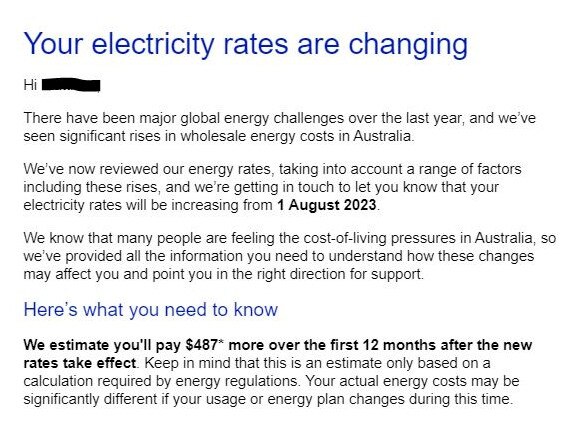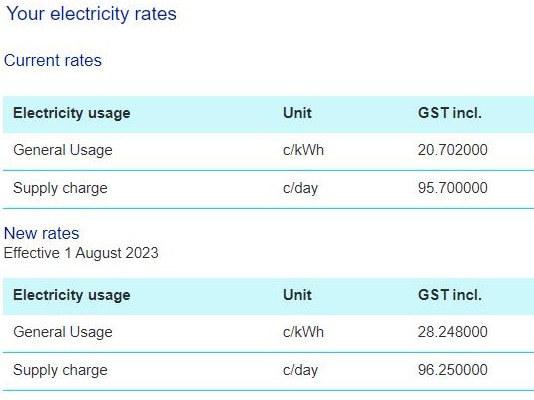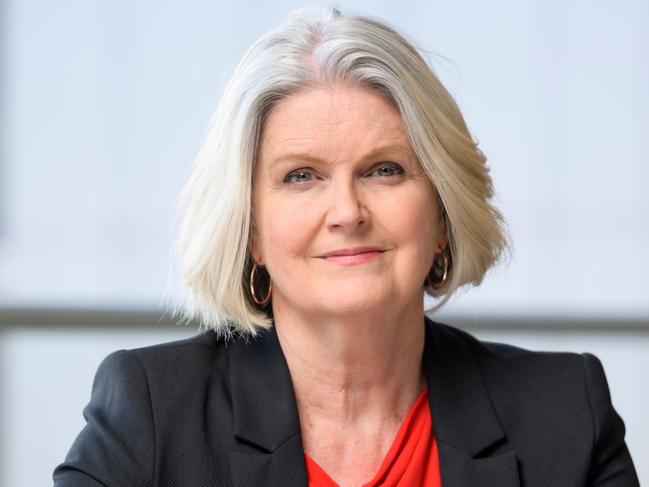Huge power bills: How Aussies can save $1000
Aussie households are being hit with huge increases to their energy bills. See how much you’ll be slugged and tips to ease the pain.
National
Don't miss out on the headlines from National. Followed categories will be added to My News.
Power prices have risen by nearly 50 per cent for some households, new billing data shows.
A search of some of Australia’s biggest providers found AGL residential customers in NSW and SA were the hardest hit, while 1700 customers on variable rate contracts copped increases of more than 45 per cent.
One AGL customer revealed their power bill had climbed 36.5 per cent, while another’s had shot up 37.3 per cent. One in NSW revealed a 54.5 per cent increase.
In NSW, AGL’s average bill increases from July 1 were 29.7 per cent ($540) and in SA, 29.8 per cent ($565).


In Queensland, AGL’s average residential power bill shot up 26.4 per cent ($447).
On August 1, Victorian customers will pay an average of 25.5 per cent ($341) more.
Origin Energy also lifted its tariffs, with its Victoria and SA customers to wear the worst of it — average household bills will climb 25.5 per cent ($361) and 24.2 per cent ($405), respectively.
QLD comes in next at 21.6 per cent ($346) and NSW goes up by 21.1 per cent ($407).

EnergyAustralia’s average household bills will rise by 25.9 per cent for Victorian customers next month.
On July 1, NSW customers saw their tariffs climb 20.5 per cent.
SA customers were met with a 17.2 per cent jump, while south east QLD saw a 11.8 per cent rise.
It comes after the Australian Energy Regulator reported a 19 per cent increase in residential electricity customers participating in hardship programs – this is now 1.3 per cent of customers, which is above pre-pandemic levels.
AGL supports 19,500 customers through its hardship program, and Origin said it was supporting 70,773 residential customers in its hardship programs, up from 47,055 last June.
An AGL spokesperson said global energy challenges over the past 18 months had led to significant rises in wholesale energy prices in Australia.
“The increase in wholesale energy prices has been mainly driven by unprecedented market volatility from increases in global fuel prices due to geopolitical factors and market conditions, along with supply disruptions,” the spokesperson said.
“Our decision to increase prices for our market contract customers is based on a detailed consideration of a range of factors.”

Australian Council of Social Service CEO Cassandra Goldie said the cost of living crisis was putting enormous pressure on people on low incomes.
“Our surveys show that 65 per cent of people on income support are cutting back on heating and 60 per cent are going without essentials like food and medication to afford their bills,” she said.
“This dire situation is only set to get worse over the coming weeks after many power providers hiked their prices by up to 30 per cent.”
She said ACOSS welcomed the Federal Government’s gas price cap but there was “much more work to be done to address soaring energy costs”.
“The Government should step in to lower retail profits and also directly assist customers in hardship before their debt spirals out of control and becomes more unmanageable.
“It must also substantially raise the rate of income support so people can afford the essentials of life such as rent, food and energy.”

Joel Gibson, of One Big Switch, said moving to a cheaper plan could save Aussies $1000.
“Since July 1, I’ve seen plans that are 10 per cent less than government reference prices and others that are 24 per cent more that government prices, so the cost of not switching could be over $1000 for some households in the coming year if they stay on a dud plan,” he said.
“There’s no such thing as good and bad power companies – just good and bad plans. Most retailers have a few plans, ranging from cheap to expensive. Their best deal might have been the cheapest on the market in June but since the price changes it might now be the 10th-cheapest.”
He encouraged Aussies to check out the Victorian Energy Compare or Energy Made Easy (for other states) for the cheapest deals or One Big Switch.
Aussies may also be available for rebates through energy.gov.au, where there’s up to $700 in support from state and federal government since July 1, Mr Gibson said.





